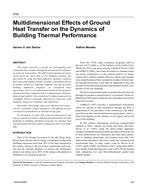Description
This paper describes a model for investigating pure conduction heat transfer through the ground and its influence on room air temperature. The differential equation of energy conservation for each node of the building envelope was discretized by using the finite-difference method, a uniform grid, and a fully implicit scheme. In order to investigate the use of simpler models for reducing computer run time of yearly building simulation programs, we considered three approaches. First, a one-dimensional model for the ground is adopted and then compared with two-dimensional and three-dimensional models. Also considered is lumped approach for a building, which is externally subjected to convection, solar radiation, long-wave radiation, and infiltration.
Internally, interchange long-wave radiation and convection are considered. People, equipment, and lighting are also considered in formulation as internal energy gain.
In conclusion, we show that it may be important to take into account the use of three-dimensional ground heat transfer modeling in building simulation programs for thermal load calculation and thermal comfort evaluations of low-rise buildings.
Units: SI
Citation: ASHRAE Transactions, vol. 110, pt. 2
Product Details
- Published:
- 2004
- Number of Pages:
- 9
- File Size:
- 1 file , 1.6 MB
- Product Code(s):
- D-23225




